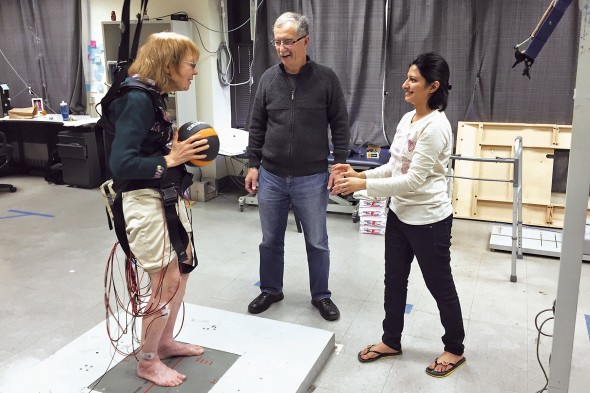Health benefits of playing catch: fewer falls for older adults

Virginia Rasmus (left) throws a ball to graduate student Sailee Jagdhane as part of a study led by UIC researcher Alexander Aruin (center) on preventing falls. Photo: Charlie Ma
You’re never too old to play catch — and it could be good for you.
The simple training exercise of catching a weighted medicine ball can improve balance and help prevent falls in older adults, according to new research at UIC.
When someone is jostled by a bump or a stumble, the brain uses two strategies to maintain balance and prevent a fall, says Alexander Aruin, professor of physical therapy and principal investigator for the two studies.
“When the perturbation is predictable, for example, if when walking down the street you see someone about to bump into you, you brace yourself,” Aruin said. The brain activates muscles in anticipation of the jolt.
The second strategy is corrective — the brain engages muscles after the perturbation to prevent us from losing our balance, he said, which might involve taking an extra step, or changing body position.
As we age, we lose our anticipatory postural control, the ability to ready ourselves to maintain balance. As a result, there is no preparatory activation of muscles, Aruin said, leaving us with only compensatory action. Our resources for maintaining balance become more limited, and we become less stable and more prone to falls.
“We know a lot about the elements of postural control,” said Aruin, who has studied that mechanism for 20 years. Recently, he and his colleagues began to investigate whether special training or exercises could improve anticipatory adjustments and help people to use them.
In one of the new studies, Aruin and his colleagues asked a group of healthy young adults to stand and catch a medicine ball. In the second study, they asked the same of a group of healthy older adults.
The researchers measured the electrical activity of leg and trunk muscles to look for differences in the two age groups’ ability to generate anticipatory postural adjustments both before and after the single short training session.
Training-related improvements were seen in both groups. In older adults, the researchers found they also improve at performing a task that wasn’t part of the training.
“There was a transfer effect,” he said. “It tells us that — potentially — what people learn in the training might be helpful with other activities. Our group is the first to look at whether a specially designed rehabilitation protocol can enhance postural control adjustment and subsequently improve overall balance,” Aruin said.
He will study the long-term effects of training to see if there’s a lasting benefit.
Nearly all the subjects, both young and old, enjoyed the training exercise, Aruin said. “It seems that most people have very positive memories associated with playing catch,” he said.
The studies appeared in two journals. Neeta Kanekar of UIC was first author on the study in the Journal of Electromyography and Kinesiology. Kanekar, Yun-ju Lee and Mohan Ganesan co-authored the study in Experimental Brain Research.
Both studies were supported by the National Institutes of Health.
